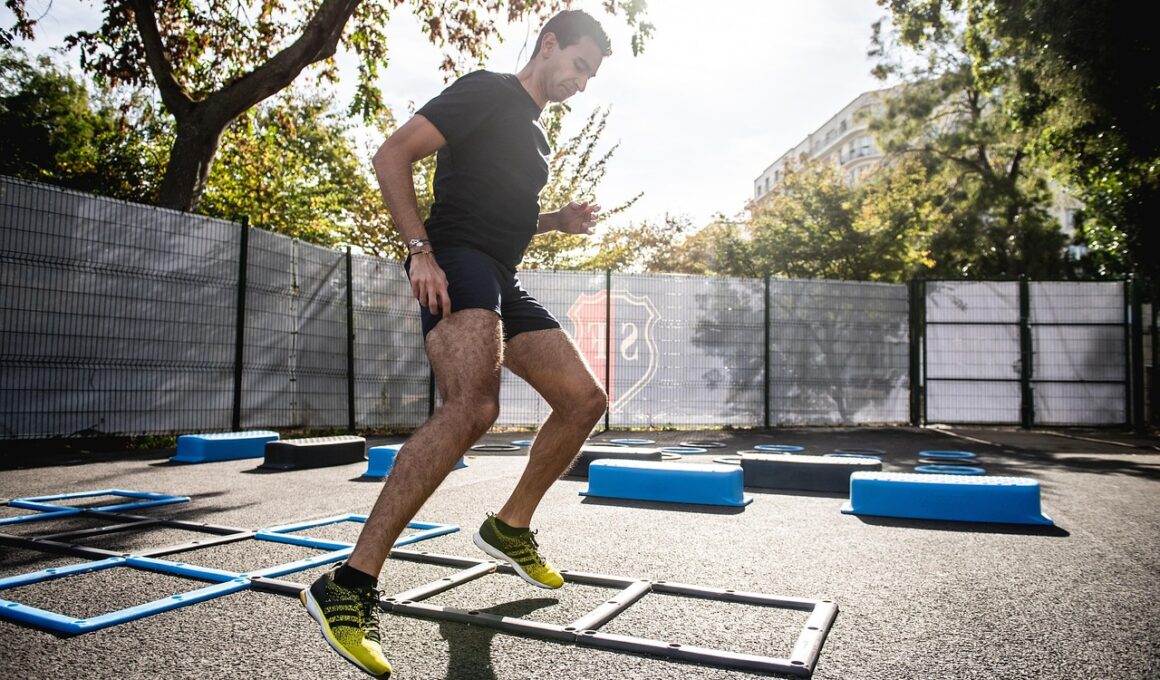Recovery Techniques After Intense Outdoor Agility Workouts
After intense outdoor agility workouts, recovery is crucial for ensuring your body heals and prepares for future training. The immediate post-workout period is key, and incorporating techniques such as hydration and nutrition can significantly aid recovery. First, replenish lost fluids by drinking water or sports drinks to maintain hydration levels. In addition to hydration, refueling with a balanced meal or snack within 30 minutes after exercise can provide your muscles with the nutrients needed for effective recovery. Aim for a meal that includes a mix of carbohydrates and proteins to kickstart muscle repair. Furthermore, consider adding some light stretching or gentle yoga after your session. This can alleviate muscle tightness and promotes blood circulation throughout the body. Engaging in low-intensity activities like walking or cycling can also enhance recovery by keeping blood flowing without placing additional strain on your muscles. Remember, adequate sleep is essential as well. Aim for seven to nine hours per night to allow your body to recover effectively. These strategies will not only help reduce soreness but also improve performance in future agility workouts.
Foam rolling is another effective recovery technique after intense agility workouts. Using a foam roller on sore muscles can help alleviate soreness and tension by increasing blood flow to the area. Spend a few minutes rolling out each muscle group, focusing on areas that feel tight or painful. Additionally, consider including contrast baths in your post-workout routine. Alternating hot and cold water can reduce inflammation and speed up recovery by improving circulation. A common practice is to spend three minutes in hot water followed by one minute in cold water, repeating this cycle for about 15-20 minutes. This method not only helps to reduce soreness but also enhances overall muscle recovery. Incorporate active recovery days into your weekly schedule, where you engage in activities that promote healing, such as swimming or light jogging. This aids in muscle recovery without the added strain of high-intensity exercises. Lastly, listen to your body. If soreness persists, allow extra recovery time before returning to high-intensity workouts to prevent injury. Prioritizing these recovery techniques will lead to better training outcomes.
Stretching and Flexibility
Flexibility training is essential for recovery after intense outdoor agility drills. Incorporate dynamic stretching before workouts and static stretching once you’re done to improve muscle flexibility and reduce tension. Dynamic stretches activate your muscles and prepare them for exertion. In contrast, static stretches help lengthen the muscles after training, promoting relaxation and blood flow. Include stretches focusing on hamstrings, quadriceps, calves, and hip flexors, as these areas often tighten during agility workouts. Holding each static stretch for around 20-30 seconds will effectively enhance flexibility. Additionally, practicing slow, controlled movements during cooldown helps your muscles return to their normal state. This transition is crucial for preventing injury as your body shifts from high-intensity work to rest. Yoga can also be a beneficial addition to your routine, improving flexibility while promoting relaxation. Research suggests that regularly practicing yoga can enhance overall performance by increasing range of motion and reducing muscle soreness. Incorporate yoga sessions into your weekly schedule to complement your agility drills and facilitate better recovery. Staying committed to proper stretching techniques will significantly improve your agility performance and overall fitness.
Nutrition plays a vital role in recovery after outdoor agility drills, with specific foods enhancing muscle repair. Incorporate lean proteins, whole grains, fruits, and vegetables into your post-workout meals to provide essential nutrients. Foods rich in antioxidants, like berries and green leafy vegetables, combat oxidative stress after intense exercise. Omega-3 fatty acids, found in fish and walnuts, are known for their anti-inflammatory properties, aiding in muscle recovery as well. Furthermore, consider protein supplements if whole food sources are insufficient. These can help in meeting your protein requirements and supporting muscle repair effectively. Eating a banana, for example, after an intense workout can quickly replenish glycogen stores due to its carbohydrate content. Also, consider hydration with electrolyte-rich drinks that can restore lost minerals during exercise. Consuming meals rich in both protein and carbohydrates within two hours post-exercise optimally supports muscle recovery. Experiment with different combinations to see what your body prefers to improve recovery times. Making nutrition a priority after workouts can lead to better agility outcomes and overall performance in your fitness regime.
Mental Recovery
Mental recovery is often overlooked but is crucial in the recovery process following demanding agility workouts. Engaging in relaxation techniques, such as meditation or deep-breathing exercises, can help reduce stress and mental fatigue. Take a few moments to focus your mind on the present, clearing away distractions, and easing anxiety about performance. Journaling can also be helpful; writing down your thoughts or feelings after workouts helps process experiences and adapt your training methods accordingly. Reflecting on your achievements and setting future goals can provide motivation and mental clarity. Visualization techniques can empower your mental state, allowing you to picture yourself succeeding in subsequent agility sessions, enhancing confidence. It’s vital to allow yourself mental breaks between intense training sessions. This will help prevent burnout and maintain your enthusiasm for outdoor workouts. Engaging in leisure activities or spending time with friends and families can significantly improve overall well-being. Balancing mental and physical recovery will keep you in top form for future agility challenges. Actually, embracing relaxation can enhance performance by allowing your mind to recover and recharge for the next training phase.
Body mechanics and physiology knowledge can further solidify your recovery protocol after outdoor workouts. Understand how your body responds to agility training by recognizing signs of fatigue and soreness. This awareness can help tailor recovery strategies more effectively. For instance, if you experience localized soreness, targeted therapies like localized ice packs can provide relief. Using compression garments is another notable technique that supports muscle recovery by reducing swelling and increasing blood flow. It can be beneficial to seek professional advice on proper techniques and exercises to improve body mechanics. Consulting a physical therapist or coach can provide tailored advice that suits your level of agility training. They can help in assessing muscle imbalances and provide effective corrective exercises that minimize the risk of future injuries. Preventing injuries through proper recovery techniques not only maintains agility performance but enhances long-term fitness commitments as well. Establishing a reliable routine when it comes to recovery fosters a sustainable training regimen that can accommodate evolving fitness levels. Keep experimenting with various techniques and strategies until you find the best fit for your body and lifestyle.
Conclusion
In conclusion, effective recovery strategies after intense outdoor agility workouts are essential for maintaining performance and preventing injuries. Hydration, nutrition, stretching, mental recovery techniques, and understanding body mechanics form the foundation of a strong recovery protocol. Adapting your recovery regimen based on personal needs and experiences is crucial; every individual reacts differently to training. By prioritizing hydration and proper nutrition, you can enhance muscle repair and readiness for future workouts. Incorporating practices like foam rolling, contrast bathing, and gentle stretching further supports recovery. Additionally, fostering mental well-being through relaxation, meditation, and positive visualization techniques can elevate your training mindset. Regularly assessing and adjusting your recovery strategies can be the key to optimizing your performance. It’s important to recognize when modifications are necessary based on how your body feels post-exercise. Maintaining an open dialogue with fitness professionals helps ensure you employ effective techniques. Keep in mind that recovery is an ongoing process, and investing time in it may lead to significant boosts in your agility performance in the long run. Embrace these recovery techniques to pave the way for continuous improvement in your outdoor agility drills.


